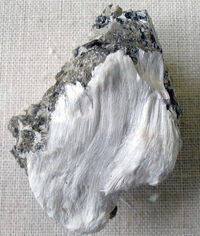| Asbestos | |
|---|---|
| [[|250px]] | |
| Type | Mineral |
| Essential mineral(s) | {{{Essential mineral(s)}}} |
| Accessory mineral(s) | {{{Accessory mineral(s)}}} |
Asbestos refers to 6 different minerals with very similar attributes. Asbestos has 2 sub-categories. They are Asbestos-Amphibole and Asbestos-Serpentine. They are categorized as such, due to the way in which they form. Serpentines form when certain igneous rocks come in contact with just-below-boiling water. A chemical reaction takes place creating a Serpentine rock. There is only one serpentine rock: Chrysotile. Amphibole rocks are generally dark, inosilicate minerals, composed of a double-chain SiO4 tetrahedron. Their chemical compositions are similar to pyroxene.
Disposal[]
All asbestos minerals can be disposed of in two ways. Either:
- They are put in a "hazardous materials" landfill
- They are superheated with a silica based material such as sand to form silicate glass
Both methods are in use worldwide, although the second method is more common. It recycles the carcinogen and removes its toxic attributes by turning a fibrous mineral into a solid glass sheet. That way, there are no fibers that may become airborne and infiltrate one's lungs and respiratory organs.
Distribution and Production[]
Asbestos is produced still in Brazil, Canada, China, Columbia, Kazakhstan, Russia, and Zimbabwe. In 2006, 2.3 million tons of asbestos was produced and distributed worldwide. Asbestos is still used in construction in some developing countries, but mostly China. China's output of asbestos generally stays local, as the majority of the Asbestos market on the buying end remains in China. To this day, however, Russia has maintained its title of "biggest asbestos producer", and had that title since it surpassed Canada in production numbers circa 1980.
Health Risks[]
Although it is relatively rare, with between 2000 and 3000 new cases reported of mesothelioma in the U.S. each year occur. Mesothelioma is still a significant risk to people regularly exposed or at one point was exposed for a period of time to asbestos. Asbestos induced lung cancer may also occur when microscopic airborne particles intrude one's respiratory system, bypassing all immunity defenses, since it is inhaled along with air.
References[]
- Mineral Facts and Problems (book)
- en.wikipedia.org
- http://www.Asbestos.net
